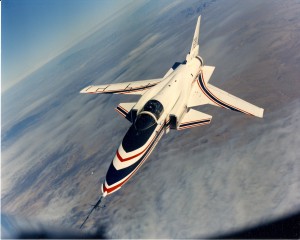Finally! An episode about airplanes again! Strap into your ejection seat, secure the canopy, and turn on the afterburners, because this episode of Technically Speaking is about to go ballistic!
On this episode of Technically Speaking, Joe and Jacob are joined by “bossman” and imaginaire extraordinaire, Ryan Haupt to talk about cool airplanes and volcanoes!
First, Ryan submitted a paper on shape-changing wings for improved efficiency that Jacob doesn’t seem terribly impressed by. How would a shape changing wing affect efficiency in the first place? How would it be built? What are the engineering tradeoffs involved in a shape changing wing? Find out when you listen!
Next, we get all nostalgic talking about X-Planes! (not the flight sim) And much to our satisfaction, NASA appears to have earmarked some funding for 2015 to invest in new, innovative aviation ideas! Does this mean that Joe and his new 3D printer will be applying for some funds? We’re optimistic (obviously), but is 79$ Million enough? I guess we’ll find out!
Lastly, in this week’s Brainstorm, we have a listener submitted question about going scuba diving IN A VOLCANO! (and luckily we have a Geologist with us to talk about it, cuz’ we know zippy-zap about Volcanoes) How hot are volcanoes, and what do we have that can resist the heat once inside? We went a little overboard on this one… but there’s just so much to talk about! Let us know what you think!
Let us know with an email, a comment on Facebook, a shout-out on Twitter, or a comment below! And if you liked the show and want to keep hearing more, be sure to leave us a review on iTunes!
Run Time: 1:25:51
Music: “Airplanes” – B.o.B feat. Hayley Williams
Podcast: Play in new window | Download


Hi Joe and Jacob,
I finally got around to listening to podcast number 22. I loved hearing Ryan on with you. Thanks for the show.
As a fixed wing and rotary wing pilot I had to jump in on this conversation. As I understand it, wings are designed to actually generate lift. The asymmetric airfoil is designed to capitalize on “Bernoulli’s principle” which produces low pressure above the wing relative to pressure below the wing. Newtons third law of motion comes into play as well, but only when the relative wind changes (Relative to the chord line, but that’s another story). This can only occur if the airspeed reaches a certain speed. And if the speed is too slow the wing will stop generating lift and “Stall”. Flaps and slats help to decrease that airspeed at which the wing stalls.
And when flying airplanes, the “stall” speed (Vs) is what you care about most.
Granted, the result of extending the flaps on an airplane is to also create more drag thus slowing the plane down.
Thanks!
Matthew Merrell.
Helicopter CFI/Instrument
Airplane Single Engine/Land
Hey Matthew,
Sounds like you’ve got a pretty good handle on it. Flaps (and slats) change the effective camber of the wing, which increases the lift generated for a given airspeed. This lowers the stall speed, which allows a lower speed approach.
A helpful side effect is the additional drag generated by the flaps helps slow the aircraft down, allowing you to fly a steeper approach. Helpful on a short field or over an obstacle, or, if you fly like I do, to bleed off the excess altitude you carried on your base leg (oops).
Joe
Student Pilot (Fixed Wing)